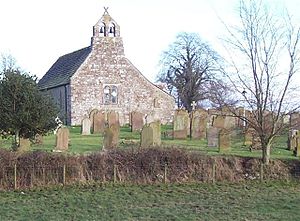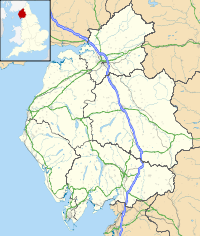- St Andrew's Church, Aikton
-
St Andrew's Church, Aikton 
St Andrew's Church, Aikton, from the westLocation in Cumbria Coordinates: 54°51′55″N 3°07′10″W / 54.8653°N 3.1194°W OS grid reference NY 282 528 Location Aikton, Cumbria Country England Denomination Anglican Website Aikton, St Andrew History Founded 12th century Dedication St Andrew Architecture Status Parish church Functional status Active Heritage designation Grade I Designated 11 April 1967 Architectural type Church Style Norman, Perpendicular Completed 1869 Specifications Materials Sandstone, slate roofs Administration Parish Aikton Deanery Carlisle Archdeaconry Carlisle Diocese Carlisle Province York Clergy Vicar(s) Revd Canon Gill Hart St Andrew's Church, Aikton, stands near the village of Aikton, Cumbria, England. It is an active Anglican church in the deanery of Carlisle, the archdeaconry of Carlisle, and the diocese of Carlisle.[1] The church has been designated by English Heritage as a Grade I listed building.[2]
Contents
History
The church dates from the 12th century, with additions made in the 13th century.[2] In the 18th century a south aisle was added, and in 1869 the church was restored at a cost of over £400 (£30,000 as of 2011).[3][4]
Architecture
Exterior
The church is built in red sandstone rubble. Many of the stones used in its construction were taken from Hadrian's Wall.[2] The chancel roof is in Welsh slate, while the roof of the nave is in sandstone slates. The plan of the church consists of a four-bay nave with a south aisle and a gabled porch, and a two-bay chancel with a gabled vestry to the north. At the west end of the church is a double bellcote.[2] The south aisle is Perpendicular in style.[5] In the north wall are lancet windows, the east window has two lights and there is a lancet window in the vestry. In the west wall is a blocked window.[2]
Interior
The roof dates from the 15th century; it is an open timber roof consisting of four king post trusses with side struts. The chancel arch is Norman in style.[2] The font dates from the 14th century. It consists of a square bowl on a pedestal; the bowl has trefoils and plain rounded decorations. In the aisle is a steeply pointed trefoiled piscina.[2][5] In the porch is a 13th-century coffin lid, inscribed with the carving of a sword.[6] The organ was built by J. Charles Lee of Coventry.[7]
See also
- Grade I listed buildings in Cumbria
References
- ^ St Andrew, Aikton, Church of England, http://www.achurchnearyou.com/aikton-st-andrew/, retrieved 13 March 2010
- ^ a b c d e f g "Church of St Andrew, Aikton", The National Heritage List for England (English Heritage), 2011, http://list.english-heritage.org.uk/resultsingle.aspx?uid=1327139, retrieved 10 May 2011
- ^ UK CPI inflation numbers based on data available from Lawrence H. Officer (2010) "What Were the UK Earnings and Prices Then?" MeasuringWorth.
- ^ Aikton Parish, Bulmer's History and Directory of Cumberland, Steve Bulman, 1901, http://www.stevebulman.f9.co.uk/cumbria/1901/aikton1901_f.html, retrieved 13 March 2010
- ^ a b Pevsner, Nikolaus (2002) [1967]. The Buildings of England: Cumberland and Westmorland. New Haven and London: Yale University Press. pp. 58–59. ISBN 0-300-09590-2.
- ^ Aikton - St Andrew's Church, Visit Cumbria, http://www.visitcumbria.com/car/chc7.htm, retrieved 13 March 2010
- ^ Cumberland, Aikton, St Andrew, British Institute of Organ Studies, http://www.npor.org.uk/cgi-bin/Rsearch.cgi?Fn=Rsearch&rec_index=N03412, retrieved 24 March 2010
Categories:- Church of England churches in Cumbria
- Grade I listed buildings in Cumbria
- Norman architecture
- English Gothic architecture
- Diocese of Carlisle
Wikimedia Foundation. 2010.

